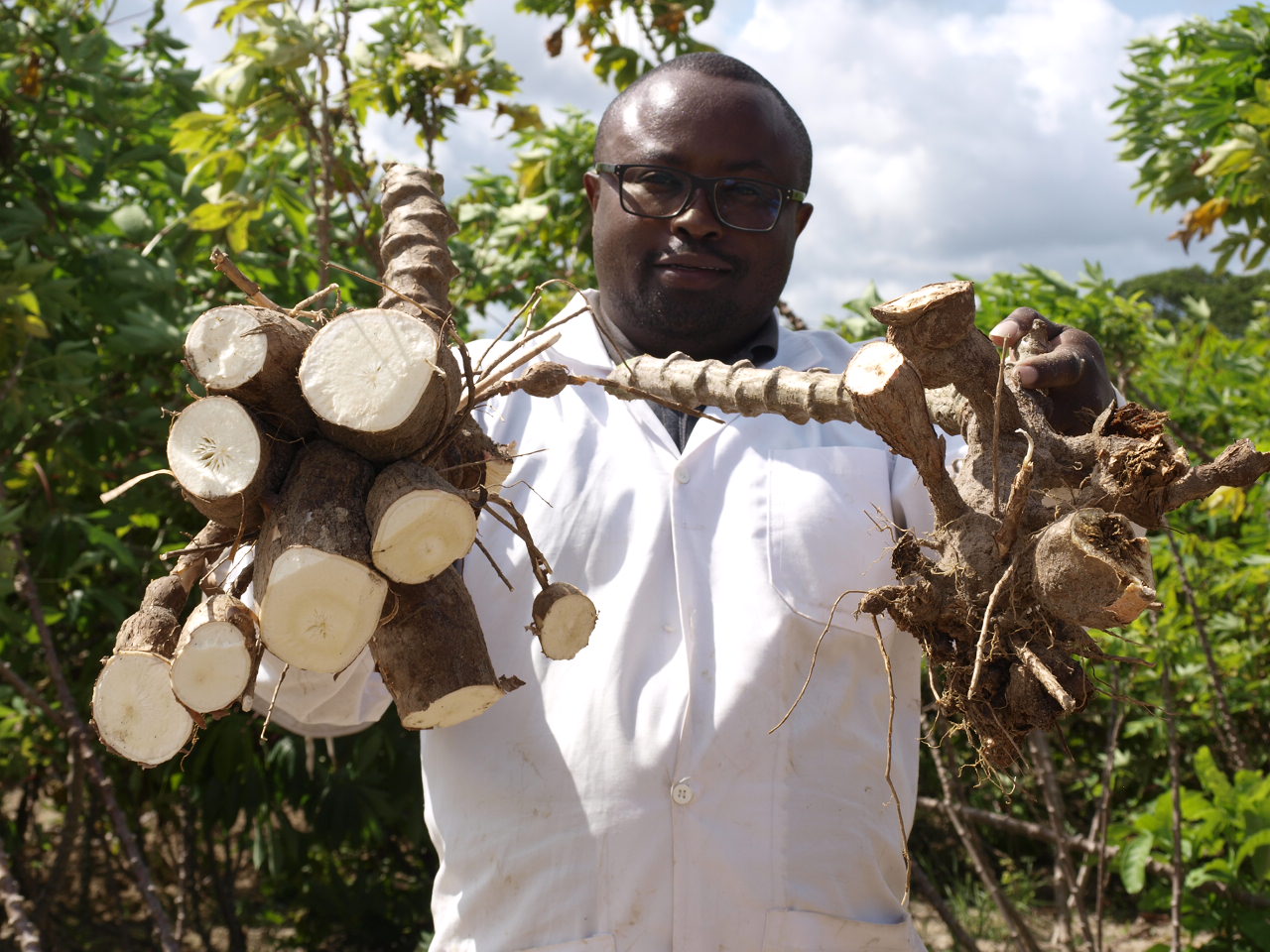At the Kenya Agricultural and Livestock Research Organization (KALRO) center in Mtwapa, Kenya, scientist Paul Kuria uproots two sets of cassava tubers exposed to the devastating cassava brown streak disease (CBSD).
One of the plants is a conventional cassava variety that has no immunity to the disease. The second has been genetically modified (GM) to resist the disease. Kuria punctiliously slices each of the tubers open, and the difference between the two is stark — like night and day.
The conventional tuber looks emaciated and is punctured with brownish, unsavory spots dotting the entire circumference of its flesh. The GM tuber, on the other hand, is the picture of good health. Its skin is flawless and firm, and its flesh has an impeccable, white lustre.
CBSD is considered one of the world’s most dangerous plant diseases due to its significant impact on food and economic security. Cassava varieties that are resistant to the disease could considerably improve the crop’s ability to feed Africa while generating income for smallholder farmers.
In severe cases, the disease can lead to 100 percent yield loss. As noted by KALRO and its partners, cassava resistant to CBSD is in high demand by farmers where the crop is grown.
Meeting that demand has been an elusive target for plant breeders. But through modern biotechnology, a collaborative effort known as the VIRCA project has developed CBSD-resistant cassava line 4046. It has the potential to prevent 90 percent of crop damage, thus improving the yield and marketability of cassava roots.
“We used genetic engineering and produced an improved cassava,” Professor Douglas Miano, the lead scientist in the project, told journalists and farmers who toured the KALRO grounds in Mtwapa in early August.
“It’s the first GM cassava in the world, and Kenya is leading in this production,” Miano said.
The VIRCA (Virus Resistant Cassava for Africa) project was conceived in 2005 with the aim of solving the viral diseases that suppress cassava yields and reduce farmer incomes in East Africa. It brings together KALRO, the National Agricultural Research Organization (NARO) of Uganda and the Donald Danforth Plant Science Centre (DDPSC) in the United States.
“We have two main diseases affecting cassava production — CBSD and cassava mosaic disease,” Miano explained. “Cassava mosaic disease affects the leaves of the crop. The net effect is a reduction in the amount of cassava that is produced. CBSD, on the other hand, destroys the roots and affects the tuber.”

Dr. Catherine Taracha, a Kenyan who is on the project’s leadership team, said that plant viruses create a huge challenge for farmers.
“Cassava productivity is significantly hampered by viral diseases, and so we sought to develop a cassava line that would resist the viruses and thereby improve farmers’ livelihoods by boosting productivity and earnings from the crop,” Taracha said.
Because the line is yet to be approved for commercial release, the work is being carried out in regulated confined field trial conditions. If and when Kenya’s National Biosafety Authority approves line 4046 for the market, the new CBSD-resistant varieties would undergo normal government variety assessment and registration by regulators before being distributed to farmers.
The scientists further assure that CBSD-resistant cassava varieties are no different than their conventional equivalents — aside from their ability to resist CBSD.
“Due to the ability to resist CBSD, these varieties will be more productive with better quantity and quality of root yields,” Miano said.. “This will translate to greater demand and more profits for farmers.”
In addition, CBSD-resistant cassava line 4046 will produce disease-free planting material and thereby contribute to long-term sustainability of the cassava crop.
There will be no technology fee associated with line 4046, scientists say, implying that cassava stakes and cuttings will cost about the same as other highly valued cassava varieties.
Cuttings from CBSD-resistant cassava can be replanted in the same way farmers replant conventional cassava. They can also be grown with other crops because cultivation practices are the same as for conventional varieties.
The developers have further assured that CBSD-resistant cassava line is safe for the environment and biodiversity.
“We have developed the GM cassava up to the point where we have conducted all the safety studies and demonstrated that it is safe as food, feed and to the environment,” Miano said.
The general public and key stakeholders have been involved in the project, and it is anticipated that farmers and communities will be involved in selecting the best CBSD-resistant cassava varieties for their needs.
Cassava roots and leaves are the nutritionally valuable parts of the plant. The tuber is rich in gluten-free carbohydrates while the leaves provide vitamins A and C, minerals and protein. In addition to its nourishing properties, stakeholders have also identified cassava’s potential to spur Kenya’s industrial growth.
“Cassava is an important food crop, but we can also use it to industrialize in Kenya,” Miano asserted. “However, we have not yet been able to achieve this as a country.”
Miano identified starch as a potential cassava product that the country can leverage to advance its industrial growth. It is also projected that the improved cassava can protect farmers from devastating losses of this important food crop and contribute to the creation of thousands of jobs along the value chain due to the crop’s use as animal feed.
The scientists note that modern biotechnology is by far the best option to incorporate CBSD resistance in cassava cultivars carrying farmer-preferred characteristics. Similar approaches have been used to confer resistance to plant viruses and have been authorized by regulatory bodies around the world, including virus-resistant pawpaw, squash and beans.
Image: Scientist Paul Kuria displays cassava infected with cassava brown streak disease (left) and a GM variety that resists the devastating disease. Photo: Joseph Maina
